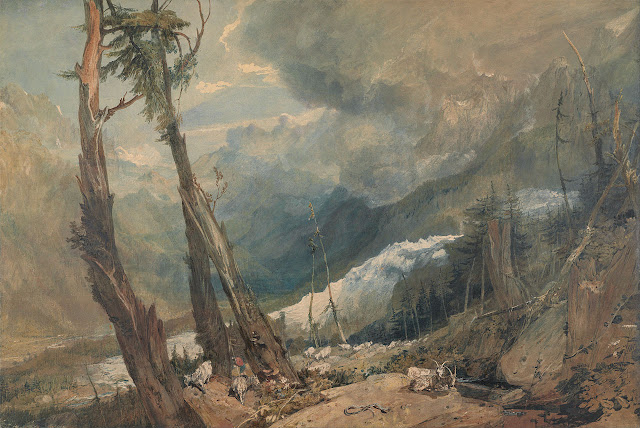 |
| Joseph Mallord William Turner A Great Tree ca. 1796 watercolor Yale Center for British Art |
 |
| Joseph Mallord William Turner Mer de Glace in the Valley of Chamouni Switzerland 1803 watercolor Yale Center for British Art |
"All things of nature extend themselves in the three dimensions of height, width, and depth. Today we take for granted, as the Greeks already did, that bodies in nature are composed of atoms and molecules. Molecules are essentially three-dimensional but are so minuscule as to be imperceptible to the human eye. Natural things confront our senses not as atoms but as atomic complexes. Insofar as we are dealing with solid bodies, these complexes appear to be persistent, that is, at least temporarily immutable. We can thus conclude that every object of nature occupies three dimensions. This three-dimensional extension, common to all natural things, we call "form."
"How do we obtain any impression of natural things external to ourselves? Through our senses. The sense of sight, or optical sense, plays the leading role in this process. But the optical sense alone does not suffice to provide us with a true sense of form. The sense of sight is unable to penetrate objects; it apprehends in a given thing merely the one surface that happens to be turned toward the viewer. That is to say, the eye perceives not a three-dimensional form but a two-dimensional surface; it sees height and width but not depth. To convince ourselves of the actuality of depth, we must call on another sense, the sense of touch, or tactile sense. The optical sense merely reveals the existence of the object; the tactile sense presents its form. Today we need only a single glance to recognize that, say, a man is standing before us. But our optical sense alone does not inform us of this; rather, we draw on our past experience in the domain of touch. Thus we would have something essential, form, given us by the tactile sense, and something illusory, surface, which the optical sense deceptively dangles before us."
– from Historical Grammar of the Visual Arts, a course of lectures delivered by Aloïs Riegl in 1899 at the University of Vienna, translated by Jaqueline E. Jung and published in English by Zone Books in 2004
 |
| Joseph Mallord William Turner London from Greenwich Park 1809 oil on canvas Tate Britain |
 |
| Joseph Mallord William Turner Lake Avernus with Aeneas and the Cumaean Sibyl ca. 1814-15 oil on canvas Yale Center for British Art |
 |
| Joseph Mallord William Turner On the Washburn ca. 1815 watercolor Yale Center for British Art |
 |
| Joseph Mallord William Turner Bay of Baiae with Apollo and the Sibyl 1820s oil on canvas Tate Britain |
 |
| Joseph Mallord William Turner Italian Landscape with Bridge and Tower ca. 1827 oil on canvas Tate Britain |
 |
| Joseph Mallord William Turner Corsica ca. 1830-35 watercolor Yale Center for British Art |
 |
| Joseph Mallord William Turner Staffa - Fingal's Cave ca. 1831-32 oil on canvas Yale Center for British Art |
 |
| Joseph Mallord William Turner Landscape with Water ca. 1840 oil on canvas Tate Britain |
 |
| Joseph Mallord William Off the Nore ca. 1840-45 oil on paper mounted on canvas Yale Center for British Art |
 |
| Joseph Mallord William Turner Paddle-steamer in a Storm ca. 1841 watercolor Yale Center for British Art |
 |
| Joseph Mallord William Turner Schloss Rosenau, Coburg ca. 1841-44 oil on canvas Yale Center for British Art |
 |
| Joseph Mallord William Turner Mountain Landscape with Lake ca. 1842 watercolor Yale Center for British Art |